Best Drill Press — Buyers Guide, Top Picks, and Comparison
Drill Press Categories
Drill Press Information
Best Drill Press Categories
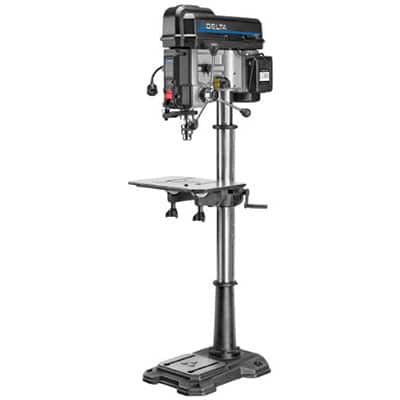
Floor Drill Press
The floor drill press is the pinnacle of drilling precision. Mounted on a pillar, you can create perfectly perpendicular boreholes into timber, wood, and plastics. A favorite amongst machinists, woodworkers, and engineers — these industrial-grade tools can be utilized to tap screws, edge, taper, sand, polish, and hone, in addition to their normal drilling feature.
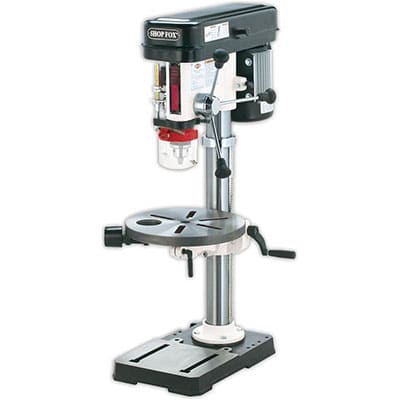
Benchtop Drill Press
The bench drill press provides unsurpassed drilling precision in a compact unit. Sufficiently small to sit on workbenches while still delivering impressive torque and speed, they’re ideal for addressing plastics, metals, and timbers. Suitable for DIYers and trade pros, they can be utilized to bore holes, polish, sand, taper, and tap screws.
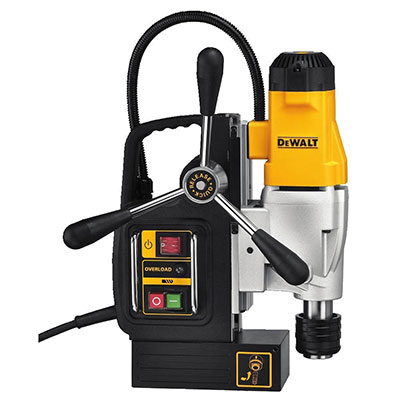
Magnetic Drill Press
Featuring an electromagnetic foot to bond tightly to base ferrous materials, the magnetic drill press is the consummate metal drill. Boasting an annular cutter instead of a bit, they’re faster than standard drills at boring into dense steel and iron, and eliminate the need for pre and/or step drilling. Typically including an internal coolant system, friction and heat are minimized, elongating the lifespan of the motor and cutting head.
Our Drill Press Top Picks In Each Category
| IMAGE | PRODUCT | DETAILS | ||
|---|---|---|---|---|
|
Best Floor Drill Press 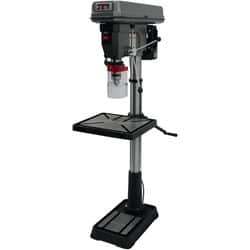
|
Best Floor Drill Press
|
Jet JDP-20MF - 3545170
|
Features
|
Check Price at Amazon Jet JDP-20MF - 3545170 Review Jet JDP-20MF - 3545170 Review |
|
Best Benchtop Drill Press 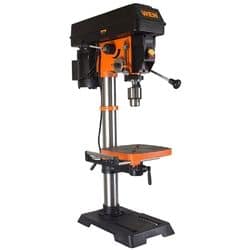
|
Best Benchtop Drill Press
|
WEN 4214
|
Features
|
Check Price at Amazon WEN 4214 Review WEN 4214 Review |
|
Best Magnetic Drill Press 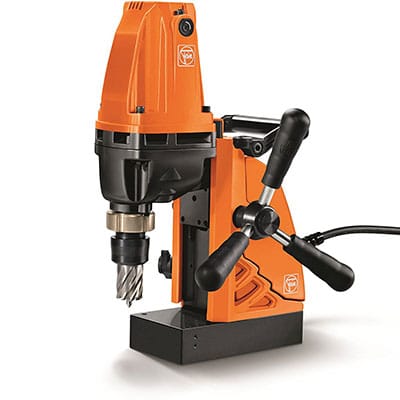
|
Best Magnetic Drill Press
|
JHM ShortSlugger
|
Features
|
Check Price at Amazon JHM ShortSlugger Review JHM ShortSlugger Review |
The Best Drill Press — Buyer’s Guide
The masters of drilling accuracy and precision, drill press machines are the go-to boring tools for both trade and DIY artisans. Delivering perpendicular drilling through their lever-controlled chuck, these units guarantee a perfect 90-degree address.
With most units being multi-medium compatible, they’re impressively versatile. And, including floor-standing, benchtop, and magnetic categories, there’s a machine for every budget, project, and user skill level.
What Is a Drilling Press?
Sometimes referred to as pedestal or pillar presses, a drilling press has a chuck or arbor mounted on a vertical column, suspending the boring bit directly above your target material.
Side-mounted levers allow you to lower and raise the drilling head onto your medium, while also enabling significant downward pressure. This delivers precise, perpendicular boring, crucial for boreholes that demand an accurate depth and address angle — for example for dowelling recesses and bolt spaces.
Furthermore, in addition to standard drilling, you can use these tools to tap screws, ream, polish, and edge — making them suitable for DIYers and trade contractors.
The drilling press arena includes three main formats — floor-standing, benchtop, and magnetic.
Drill Press Comparison of Types
Floor Drill Press
The mother-of-all pillar drilling machines. Often referred to by professionals as a commercial drill press, these tools offer the most significant power output and material size capacity in the whole pedestal arena.
Free-standing and weighing around 200 pounds, they take up considerable garage, shed, or workshop space — and once in-situ, are typically too hefty to relocate once your project is complete.
However, their considerable bulk permits them to be the ultimate professional drill press or serious amateur boring tool.
They boast generous material tables of 7-9 inches, with many models including an extending feature that can double their capacity. Furthermore, often incorporating a wide speed range — typically from around 200-3000 rpm — they permit you to select the optimum velocity for your medium type.
Pros of Floor Drill Pillar Presses
- High power and speed output.
- Large material capacity.
- Stable and wobble-free.
- Pro-grade.
- Suitable for metal, timber, and plastic.
Cons of Floor Drill Pillar Presses
- High power and speed output.
- Large material capacity.
- Stable and wobble-free.
Benchtop Drill Press
Compact and affordable — yet offering similar capabilities to floor-standing machines — bench drill presses are the consummate light contractor and dedicated DIY perpendicular boring tools.
As their name suggests, they’re designed to sit upon benches — saving you floor space. However, bear in mind that they will still absorb considerable worktop area. And, while at around half the weight of their free-standing counterparts, these units will require significant effort to relocate.
Impressively, these tools knock out similar velocity ranges to the floor models — although they can be somewhat lacking at the lower end speeds, making them less suited to addressing seriously dense mediums.
Pros of Bench Pedestal Press Drills
- The most affordable drill press format.
- Excellent for DIYers and hobbyists.
- Take up less area than floor units.
- Can be bolted to workbenches.
- Straightforward operation.
Cons of Bench Pedestal Press Drills
- While relatively compact — they’re still heavy.
- Likely to ‘walk’ unless bolted.
- Lacking in lower speed choice.
- Smaller material size capacity than free-standing units.
Magnetic Drilling Press
The magnetic drilling press, known in trade circles as a mag drill, is the ultimate perpendicular cutting tool for boring ferrous metals. While sharing the same pillar-mounted drilling head and side-levers as their floor and bench siblings, these machines boast a novel feature — a magnetic foot.
This permits the unit to strongly adhere to your target (metal) medium — ensuring optimum stability and guaranteeing the most accurate address possible. Furthermore, it means that these tools can be used vertically, horizontally, and upside-down — making them excellent for attacking immovable materials such as stanchions and I-beams.
One other small, yet significant, difference to other formats of drill press is the arbor. Replacing the traditional chuck, it permits the mag unit to utilize an annular cutter instead of a bit. This boring head only cuts the outer rim of the hole, making it faster and more efficient than a standard press.
The only major downside of these drills is that they’re material-specific. While excellent for iron-based mediums, they’re pointless for non-ferrous materials such as aluminum, wood, and plastic.
Pros of Magnetic Pillar Drills
- Best portable drill press for metal.
- Can be utilized away from the vertical plane.
- Powerful magnets to reduce wobble and walk.
- Efficient annular cutting heads.
- High torque, low speed.
Cons of Bench Pedestal Press Drills
- Unsuitable for wood, plastic, and non-ferrous metals.
- Typically only single or dual speed.
- Internal coolant systems.
- Maximum two-inch cutting depth and width.
Uses for a High Quality Drill Press
Although not an exhaustive list, you can use a good drill press for:
- Boring precise holes in metals, woods, and plastics.
- Reaming.
- Tapping.
- Tool sharpening.
- Routing.
- Countersinking.
- Mortising.
- Fence post boring.
- Polishing.
- Fabricating.
- Milling.
- Sanding.
- Creating recesses for dowels.
- Building fabrication.
- Engine mounting repair.
Considerations When Purchasing Drill Pillar Presses
The three different pedestal press categories have individual characteristics when selecting the ideal machine for your project. Hence, if you have a preference for a particular format, I suggest checking out my detailed buying guides to floor-standing, benchtop, and magnetic machines.
However, as a general purchasing overview of the whole pillar drill universe, here are a few areas I recommend looking at:
Format
As detailed above, there’s a triumvirate of pillar press formats — floor-standing, benchtop, and magnetic.
When selecting your ideal machine, it’s insufficient just to look at drill press reviews — you need to consider what type of pedestal unit is most suitable for your projects.
In brief, for industrial-grade performance and capacity, opt for a floor-standing machine. If space is limited, or you’re more a DIYer than a contractor, think about a benchtop tool. And, for perfect precision ferrous metal boring, go for a mag drill.
Speed Range
Usually declared in rpm, the speed details the rate at which the bit or annular cutter rotates.
For the ultimate in versatility, look for a unit that delivers the greatest spectrum of velocities — from a steady, slow turn through to high-intensity rapid rotation. This permits you to select lower end speed for dense mediums such as metal, and elevated revolutions for soft timbers.
That said, mag drills, being designed for stubborn metals, usually only feature one or two velocity choices at bottom-end rpms — crucial to shield the cutter and motor from overheating.
Swing
An essential consideration, particularly when selecting your consummate floor or bench pillar press.
The swing is defined as the distance between the drill bit and the rear column — multiplied by two. This explains the maximum width of material you can place on the unit’s table to create a centrally placed hole.
Unsurprisingly, floor-standing units have a greater swing than their benchtop siblings — typically 15-20 inches as opposed to around 12 inches for the worktop tools. Hence, if your projects involve substantially-sized mediums, go for the floor drills.
That said, the magnetic pillar drill format is an exception. As it sits upon the target material instead of the medium being placed within the confines of the tool, there’s no limit to the volume of the target metal sheet, joist, or block it can address.
Portability
Generally speaking, pillar drills are the least portable of all the drill categories — especially the floor and bench formats.
Admittedly, the bench types are smaller and lighter weight than floor-standing models — but still, their inherent mass and bulk mean you’re not going to be moving them from site to site.
Mag drills are the most portable — although they still weigh around 50 pounds. Thankfully, their magnetic base means you don’t have to support them during operation.
Conclusion
Commercial, semi-pro users, and guys tackling significantly sized materials should opt for a floor-standing unit. Most DIYers will appreciate the high power yet compact size of the bench machines — while skilled metalworkers are best to go for the portable mag drills.
When selecting your perfect tool, consider the size of the swing, its speed range capabilities, the format that best suits your most common applications, and the level of movability it offers.
Sure, they’re not for everyone. Typically only offering perpendicular drilling, and unsuitable for addressing concrete, brickwork, or masonry — their uses are limited.
But if you’re a guy who demands the pinnacle of precision — nothing can surpass a pedestal drill press.
Drill Pedestal Press Machines FAQs
Q: Who Makes the Best Drill Press?
Due to their function-specific nature, the best pillar press drills are typically manufactured by companies that specialize in precision machining — hence the absence of many of the familiar drill brand names. When selecting your ultimate pedestal press tool, I suggest checking out the brands of Jet, WEN, and JHM.
Q: Which Floor-Standing Unit Has the Best Drill Press Reviews?
From online reviews, user opinions, and my own experience, I feel that the best floor-standing machine is the Jet JDP-20MF – 3545170. It boasts a brawny 1.5 horsepower motor, 12 speed settings, and a velocity range of 150-4200 rpm.
Q: What Is the Best Drill Press Brand for Mag Drills?
In my opinion, I suggest checking out the brands of JHM, Hougen, and Milwaukee for the most reliable and versatile magnetic drill press units. For me, the pinnacle of mag drills is the Shortslugger, which features 1800 pounds of magnetic force, a steady 430 rpm, and a 750-watt motor.
Q: What Machine Has the Best Drill Press Rating?
Boasting a generous 9.5-inch extending table, a 12-inch swing, and a vast 530-3200 rpm speed range — for me, the most impressive drill press is the benchtop WEN 4214.
Q: What is a Drill Press Good For?
Drill presses — sometimes called pillar or pedestal presses — allow you to bore impressively accurate and precise holes into plastic, metal, and wood. They can also be used for screw tapping, countersinking, reaming, and mortising.
Q: What Does 10 Drill Press Mean?
A 10 drill press refers to the fact that the pedestal machine can bore a hole in a piece of material that has a maximum width of 10 inches. This distance is typically referred to in drill press literature as the swing. Sizes of the swing can range from 6 inches in benchtop models through to 20 inches in floor-standing machines.
